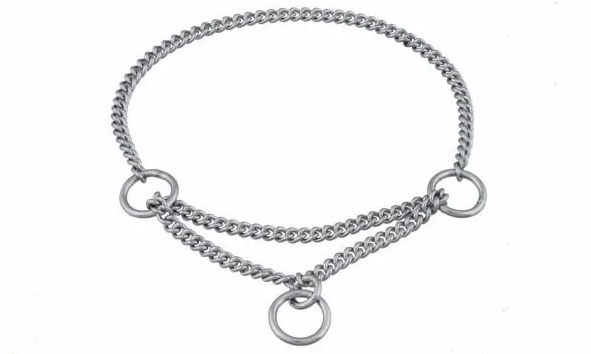Martingale collars with chains, often referred to as chain martingale collars, are a valuable tool in the world of dog training and handling. Understanding their mechanisms, benefits, and safe usage is crucial for any dog owner or handler looking to improve control and safety during walks or training sessions.
Understanding Chain Martingale Collars
Martingale collars with chains are specialized training collars designed to provide gentle control over a dog's movements without causing discomfort or harm. Unlike traditional flat collars, martingale collars with chains feature a loop of chain that tightens when tension is applied, discouraging pulling or lunging behaviors.
What is a martingale collar with chain?
A martingale collar with chain consists of two loops: a larger loop that goes around the dog's neck and a smaller loop with a chain attachment. The leash is connected to the smaller loop, allowing for controlled tightening when necessary. The chain portion of the collar ensures swift response to leash tension without excessive force.
How does a chain martingale collar work?
When the dog pulls or tries to escape, the chain loop tightens, applying pressure evenly around the neck. This tightening sensation discourages pulling behavior while still allowing for comfortable movement when the dog is not pulling. The design prevents the collar from slipping off over the dog's head, making it a secure option for walking or training.
Benefits of Chain Martingale Collars
Chain martingale collars offer several advantages for both dogs and their owners, making them a popular choice among trainers and handlers.
1. Gentle Correction: One of the primary benefits of chain martingale collars is their ability to provide gentle correction without causing harm to the dog. The even pressure distribution around the neck helps discourage pulling or lunging behaviors without choking or causing discomfort.
2. Preventing Escapes: The design of chain martingale collars makes them particularly effective at preventing dogs from slipping out of their collars. The tightening action of the chain loop ensures a secure fit, reducing the risk of escape during walks or training sessions.
3. Training Aid: Chain martingale collars can be valuable training aids for teaching dogs proper leash manners and obedience commands. The controlled tightening reinforces desired behaviors while discouraging undesirable ones, helping dogs learn quickly and effectively.
Choosing the Right Chain Martingale Collar
Selecting the appropriate chain martingale collar is essential to ensure both effectiveness and comfort for the dog.
1. Material Considerations: When choosing a chain martingale collar, consider the material used in its construction. Opt for high-quality materials such as stainless steel or chrome-plated steel for durability and resistance to rust or corrosion.
2. Proper Fit: Ensure the collar fits properly to prevent discomfort or injury to the dog. The collar should be snug but not too tight, allowing for two fingers to fit comfortably between the collar and the dog's neck. Adjust the collar accordingly to ensure a secure and comfortable fit.
3. Durability: Choose a chain martingale collar that is durable enough to withstand daily wear and tear. Look for reinforced stitching and high-quality hardware to ensure longevity and reliability.
Using a Chain Martingale Collar Safely
While chain martingale collars can be effective training tools, it's essential to use them safely and responsibly to prevent injury or discomfort to the dog.
1. Avoiding Over-Tightening: Avoid over-tightening the collar, as this can cause discomfort or restrict the dog's breathing. Monitor the fit regularly and adjust as needed to ensure a comfortable and secure fit.
2. Regular Inspections: Inspect the collar regularly for signs of wear or damage, such as fraying or broken hardware. Replace the collar if any damage is detected to prevent accidents or injuries.
3. Proper Usage During Training: Use the chain martingale collar responsibly during training sessions, avoiding harsh corrections or excessive force. Focus on positive reinforcement techniques to encourage desired behaviors and build a strong bond with your dog.
Alternatives to Chain Martingale Collars
While chain martingale collars can be effective for certain dogs and situations, they are not suitable for every situation or training need. Consider alternative options based on your dog's temperament and training requirements.
1. Traditional Martingale Collars: Traditional martingale collars, which use fabric or nylon instead of chain, can provide similar control and security for dogs who may find chain collars uncomfortable or intimidating.
2. Flat Collars: Flat collars are simple and lightweight options suitable for dogs who do not require additional control or correction during walks. They are comfortable for everyday wear and can be personalized with tags or accessories.
3. Head Halters: Head halters provide gentle control by redirecting the dog's head and focus, making them effective for managing pulling or reactive behavior. They are particularly useful for larger dogs or breeds with strong pulling tendencies.
Conclusion
Chain martingale collars are versatile training tools that can help unleash your dog's potential by providing gentle control and reinforcement during walks and training sessions. By understanding their mechanisms, benefits, and safe usage, you can effectively train and handle your dog with confidence and ease.


No comments yet